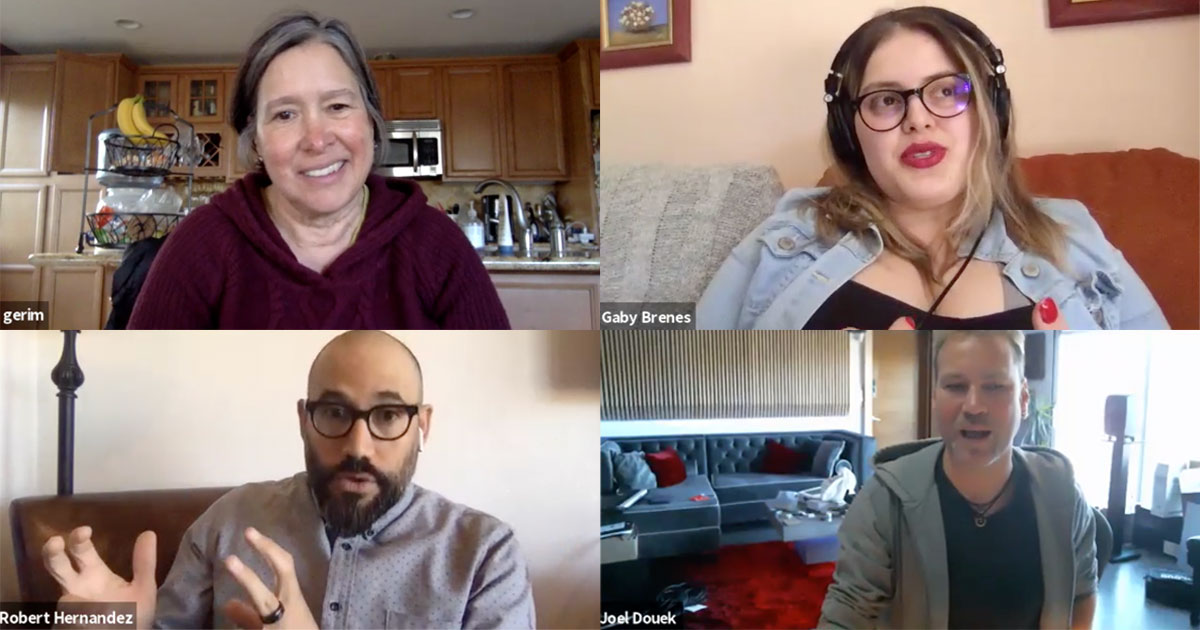We all know that journalism is a rapidly evolving industry — which means that if you’re teaching journalism, it’s important to stay on top of the newest developments in order to train the next generation of digital journalists.
To foster more connections among the ONA Educators community, we’re virtually gathering members each quarter to tackle journalism topics from an education perspective. These talks offer space for educators to share their teaching methods and how they connect students to new tools.
Our first talk focused on methods of teaching immersive storytelling with virtual reality and augmented reality. The conversation was moderated by Tiny World Productions’ Lakshmi Sarah and featured USC’s Robert Hernandez, Ecco’s Joel Douek, Chicas Poderosas’ Gaby Brenes and Stanford’s Geri Migielicz. Here are some of the most important takeaways.
Where do you start?
There are so many rich aspects of immersive storytelling to explore that it can be hard to choose what to begin your course with. The speakers agreed: Always start with the story. “The story should drive the decisions,” said Geri. “Then all your motivation is driven for content reasons and not, ‘Let’s do this cool thing!’ and then [later, you wonder] ‘Well, why did we do this cool thing?’”
Joel emphasized that it’s also important to reframe what makes a story for your students, since immersive stories are often experienced rather than told. Gaby voiced that sometimes people coming from more traditional backgrounds don’t always know what they’re allowed to do, and you want to encourage them to think outside the box.
Prototyping can also be extremely helpful to sort out what works and what doesn’t, especially if your university has limited gear. If you’ve already done your testing, you can make the most of your camera time and come back from the field with something that’s really useful.
Beat the silos
Word of mouth is key to attract interdisciplinary students to immersive storytelling classes and overcome the bureaucracy that can pin students within specific departments. “The best endorsement that a professor can get is when one student tells another to take the class,” said Robert.
It also helps to showcase your students’ work in a way that has value — projects from Robert’s classes have been published in Al Jazeera and the Los Angeles Times — so that other students can see what their participation can lead to. Geri also recommends recruiting from specific departments where the skills overlap, like computer science or engineering.
Best advice
To wrap up the session, each speaker shared their most important piece of wisdom.
Robert: Don’t ask for permission! Get cheap gear and start experimenting. Find your allies in the ONA Educators community and be inclusive.
Joel: Don’t forget about sound! Think about it at the very beginning of your project. It will help you tell your story better.
Geri: Play, experiment and fail. Professional journalists don’t have room to fail, so we, as educators, have the responsibility to break stuff and share what we learn.
Gaby: Make it a human experience. Even if your work is beautifully executed, the moment your viewers start thinking more about the tech than the story, we’ve failed. You don’t need expensive equipment to tell a good story.
Resources for teaching VR and AR
Explore these stories and resources shared by speakers and other participants in this first ONA Educators Talk:
- 360-degree immersive stories on Peninsula Press, a project of the Stanford Journalism Program
- In the Blink of a Mind, a series by Jessica Brillhart on the language of virtual reality and editing techniques
- Homeless Realities, JOVRNALISM project on homelessness in the Los Angeles area
- The Role and Value of Sound in Virtual Reality
- Virtual reality as a possibility space, Monika Bielskyte
- VR content to teach other subjects
- Narrative analysis of experiences with VR, white paper by foundry10
- Crafting Stories for VR, Melissa Bosworth and Lakshmi Sarah
Join the ONA Educators group on Facebook to get involved with the community and hear about the next talk. Have an idea for a topic? Whether you’re an expert or just want to learn more, email Meghan Murphy, ONA’s Senior Manager of Communities and Local Journalism Initiatives, at meghan@journalists.org.

